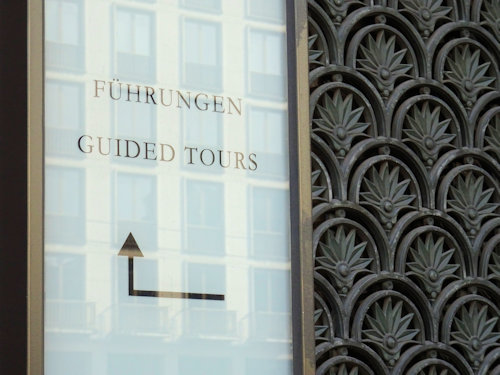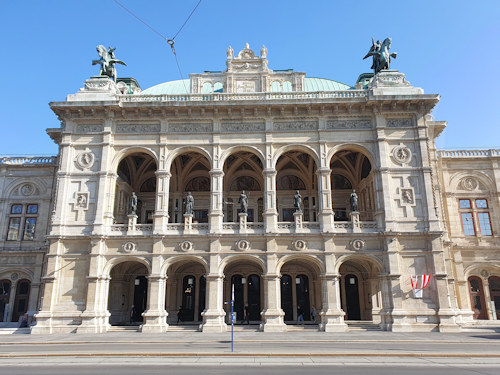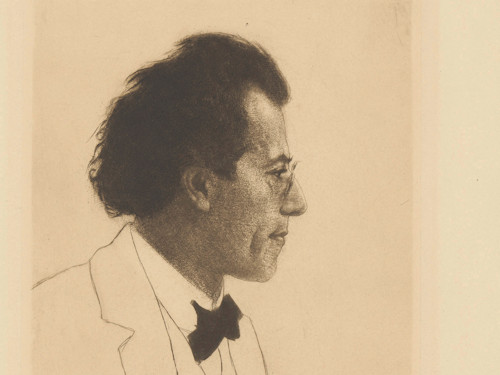
Anyone wishing to get a good look around Vienna’s State Opera House has two choices. Either buy a ticket for a performance (cheaper than you think) or take an in-house guided tour.
The advantage of the tour is you see one or two fascinating places that the opera goer cannot access.
- Explore such areas as the foyers, staircases, intermission rooms, and auditorium
- Guide has plenty of interesting operatic anecdotes
- Tours available in English; mine took around 40 mins
- Book a concert experience* for your trip
- See also:
- Opera in Vienna
- The State Opera House
- One-time tour included in the Vienna Pass
- Best hotels nearby
Go inside the Staatsoper

(Pointing you in the right direction)
The State Opera House (Staatsoper) is a grand old building that dominates one part of Vienna’s mighty Ringstrassen boulevard.
The list of famous opera stars who performed here might be considered Wagnerian in length. One of them – Placido Domingo – once received an 80-minute standing ovation for his Othello (a world record at the time of writing).
That Domingo anecdote is one of many you might hear on a guided tour from the Staatsoper’s staff, as you drift through an institution dripping in history and decor.
All is not quite as it seems, however.
Although constructed in 1869, WWII bomb damage wreaked havoc on the building. So today’s State Opera House is part-original, part-restored and part-modern, all of which you see on the tour through foyers, staircases, intermission rooms, and beyond.
The highlights

(It looks even better inside)
Most people justifiably marvel at the giant staircases leading away from the entrance foyer. But personal highlights for me on the tour I went on were…
- The Teesalon: the average opera goer typically misses this sneak peek into the former private chamber of Emperor Franz Joseph
Large wooden doors lead almost directly to the Emperor’s box and the room has more decorative elements that you can shake a libretto at.
- The Schwindfoyer: a beautifully-restored intermission room dating back to the building’s construction
150-year-old chandeliers light the room, with the walls and ceilings graced by gilt floral decoration, frescoes, and a series of composer busts: Rossini, Mozart, Gluck, Schubert, Haydn, Beethoven, and others who knew their way around sheet music.
- The auditorium and stage: now the technology takes its turn to impress
A visit to the giant auditorium includes good views of the incredibly large stage with its beams, escalators, ropes and mysterious technologies for shifting scenes and setups when each evening brings a different opera.
We were lucky enough to witness the stagehands preparing for the next performance: ancient Egypt (Aida) gradually replaced 16th-century Cyprus (Otello).
- The Mahlersaal: an intermission room rebuilt in the 1950s, with tapestries portraying scenes from Mozart’s Magic Flute
In one unobtrusive corner sat a travelling piano that belonged to none other than Gustav Mahler. Vienna is full of such gems.

(Gustav Mahler was once Staatsoper director and an important moderniser of the opera-going experience. Image courtesy of the Rijksmuseum)
While the sights impress, perhaps the real highlights are the stories, anecdotes and facts whipped out by the tour guide. For example, the State Opera House has some 180,000 costumes at its disposal and 200 stagehands work every day to make those backstage changes.
All-in-all, the tour’s a lovely way to see inside (literally and figuratively) one of the world’s greatest opera venues.
Tickets & visitor tips
Understandably, no fixed schedule exists for tour times, especially during the opera season (usually September to June) when the nature of the ever-changing daily performances can limit access.
Fortunately, the Staatsoper does provide an advance timetable, ticket info, and online booking opportunities at their website.
Note that a Vienna Pass sightseeing pass includes one-time participation on the tour at the time of writing.
The English tour should usually be available at all scheduled times, and everything was very well-organised and swift on my visit; the opera tour is one of many tours of historical buildings available in Vienna.
(Incidentally, if you want a glimpse of what that post-WWII rebuilding effort looked like, check out the photos at the Google Arts and Culture Staatsoper website.)
How to get to the State Opera House
As such a dominant city centre building, you can’t miss the Staatsoper on your walking tours of the old town. But for public transport tips, etc., see the bottom of the main article on this grand old venue.
Address: Opernring 2, 1010 Vienna